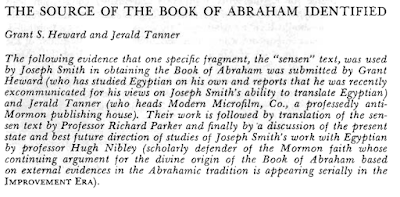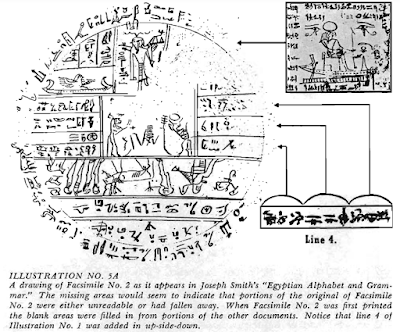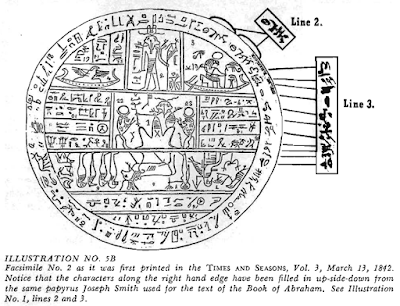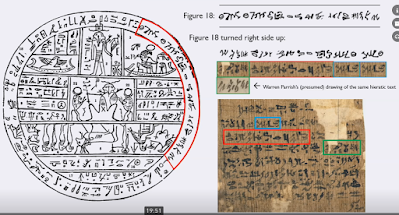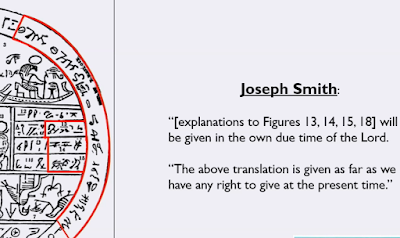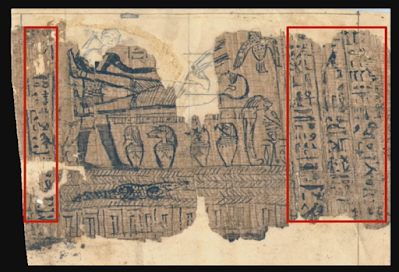In several posts over the years here at Mormanity and on my website, I've noted that the arguments of our critics against LDS scriptures, our doctrines, and the Restoration are sometimes actually helpful. Sometimes they help us reconsider sloppy assumptions and improve our understanding of the scriptures or our history. Sometimes they drive us to study complex issues more carefully, perhaps even leading to new discoveries that turn apparent weaknesses into strengths. And sometimes they can unintentionally hand us gifts that help us overcome difficult challenges. One such gift can be found in an early "anti-Mormon" attack on the book of Abraham. I use the word "anti-Mormon" infrequently of late, but the introduction (shown below) to the unintentionally beneficent article in question mentions that one of the authors, Jerald Tanner, heads a "professedly anti-Mormon publishing house." I suppose he did not object to the label and as perhaps the most famous if not most successful anti-Mormon crusader who made a career out of his passion, it's probably a fair term. But my focus here is on the gift, not the givers.
For decades, a gift regarding the translation of the book of Abraham has been staring us in the face in the analysis provided by Grant S. Heward and Jerald Tanner in "The Source of the Book of Abraham," Dialogue: A Journal of Mormon Thought 3/2 (1968): 92–97. This gift is not obvious until one reads their article and then looks again at Joseph's commentary on Facsimile 2. The gift, though, seems to have remained unrecognized until the 2020 FairMormon Conference when Tim Barker gave a significant presentation pointing out what many of us should have recognized years ago. Tim's presentation, "Translating the Book of Abraham: The Answer Under Our Heads," is available (but behind a paywall) at the FairMormon Conference Streaming 2020 page for those who have purchased the $30 pass to watch the full set of videos from the conference. The transcript with images from the slides, however, is now available at FairMormon.com [link added 1/11/21]. Tim's presentation is not yet on YouTube, unfortunately, but I'll share a touch of the content and hope you'll watch the entire presentation and the rest of a truly excellent conference.
First, here's the introduction to Heward and Tanner's article in a special 1968 edition of Dialogue devoted to book of Abraham issues shortly after the Joseph Smith Papyri were found in the Metropolitan Museum of Art (the Met) in New York City (click to enlarge):
Heward and Tanner make the basic argument against Joseph Smith as a translator by pointing out what nearly every attack on the book of Abraham today relies upon: there are book of Abraham manuscripts in which a few Egyptian characters from one of the Joseph Smith Papyri, now known as JSP XI (viewable on the Joseph Smith Papers website), are in the margins of the manuscripts, as if Joseph had translated each character to give large blocks of English text (sometimes about 200 words for 1 character). You can see these manuscripts on the Joseph Smith Papers website, where the three key documents with Egyptian characters on the left are called book of Abraham Manuscript A, Manuscript B, and Manuscript C. "Translating" many dozens of words from one character is not only utterly ridiculous, but now that ancient Egyptian can be read and translated, it is clear that the characters used have nothing to do with the book of Abraham text and in fact are part of the Book of Breathings. Thus, the book of Abraham is said to expose Joseph as an uninspired and ridiculous fraud. This argument, of course, relies on the assumption that the book of Abraham manuscripts in question are a "revelatory" work product giving us a "window" into how Joseph Smith allegedly translated a handful of characters into the book of Abraham.
Apologists have responded with a variety of arguments, often pointing out that JSP XI does not match the description of the scroll Joseph translated, that there were other scrolls that were sold after Joseph's death and burned in the Great Chicago Fire that were not part of the tiny collection of fragments that survived (the missing scroll theory), or suggesting that the translation by revelation need not be directly from any of the scrolls that were in Joseph's possession but may have been merely "catalyzed" by the papyri. It has also been argued that the manuscripts with Egyptian characters next to English text appear to be a product from the scribes done for unclear purposes after the translation had already been done, in which the characters might have been added as decorative elements, as mystic representations being explored in connection with W.W. Phelps' fascination with the hypothesized "pure language" of the ancients, as scribal attempts to crack the Egyptian language based on their assumption that JSP XI must have some connection to the book of Abraham since Facs. 1 was physically connected to it, or as "reverse ciphers" to create a code to convey what was in the book of Abraham text. But we are still left with an apparent association of some kind between characters on JSP XI and the book of Abraham text. If they weren't being translated to give the book of Abraham, what was?
If only we had more information from Joseph about what he did or did not translate. Wonderfully, thanks to the gift from Heward and Tanner, coupled with a straightforward connecting of the dots by Tim Barker, we now can answer the challenge much more clearly.
Heward and Tanner make the important observation that characters from JSP XI, particularly characters from lines two through four of that fragment, were also used to fill in a missing portion of Facsimile 2, the round figure known as a hypocephalus. The characters on lines two and three are part of the group that were added in the margins of book of Abraham Manuscripts A, B, and C. On p. 97 of Heward and Tanner, Illustration 5A shows how characters from line four of JSP XI were added to three lines of missing text on the right side of Facs. 2 (click to enlarge):
Illustration 5B on the same page shows where characters from lines two and three of JSP XI went on the completed Facs. 2:
As a result, some of the same characters allegedly used by Joseph to translate the book of Abraham were inserted onto Facs. 2 as Joseph and Reuben Hedlock, the craftsman who engraved the lead plates for print the facsimilies, prepared a portion of the book of Abraham for publication in 1842. Tim Barker shows that the the rim of Facs. 2 also has characters from line 4 of JSP XI which are also used in Manuscripts A, B, and C (click to enlarge):
Thus we have text from lines 2 through 4 of JSP XI, the papyrus fragment said to be the source for Joseph's "translation" that gave us the book of Abraham, inserted into several portions of Facsimile 2.
Now, as Tim Barker so thoroughly pointed out in his August 2020 presentation, note what Joseph Smith said about these characters in his comments on Facs. 2:
The text in three lines on the central right panel, labeled as Figures 13, 14, and 15, and the text in the rim, labeled as Figure 18, are all treated the same in Joseph's comments. The explanations for those characters "will be given in the own due time of the Lord." That declaration is followed by this statement that refers to all the comments made regarding Facs. 2: "The above translation is given as far as we have any right to give at the present time."
Here we have the words of Joseph Smith (or at least words prepared with his authorization and approval) telling us that the characters that are on this Facsimile and on book of Abraham Manuscripts A, B, and C have not yet been translated, and that Joseph had no right at that time to translate them. Whatever the scribes of those puzzling manuscripts, Frederick G. Williams, Warren Parrish, and William W. Phelps, thought they were doing with the Egyptian characters added to portions of Joseph's revealed text for the book of Abraham, the explanations on Facs. 2 strongly suggest that Joseph had not used characters from JSP XI as the source for the book of Abraham translation. "Joseph clearly indicates that he did not translated JSP XI," Barker explains. The foundation for many attacks on the Book of Mormon simply fails once we understand the significance of the gift we were handed by the astute observation of Heward and Tanner that help us see what Joseph really thought about the "smoking gun" papyrus fragment that they and critics ever since, along with some LDS intellectuals, have been telling us about what Joseph used for his translation. That's quite a gift.
Some have questioned whether the comments on Facs. 2 really came from Joseph. Barker points to Joseph's journal of March 4, 1842, just a couple days after Facs. 1 and the book of Abraham up to Abraham 2:18 were printed in The Times and Seasons. The text in that installment covered the same scope as the text in the longest of the three book of Abraham manuscripts, Manuscript C. Joseph's journal then describes how he was working with the engraver to prepare additional material for printing:
March 4 Friday Exhibeting the Book of Abraham. in the original. To Bro Reuben Hadlock [Hedlock]. so that he might take the size of the several plates or cuts. & prepare the blocks for the Times & Seasons. & also gave instruction concerning the arrangement of the writing on the Large cut. illustrating the principles of Astronomy.Joseph was giving directions to the engraver, Reuben Hedlock, regarding the writing on Facs. 2, which was published with text from Abraham 2:19 to 5:21 (the rest of what we have in book of Abraham) about two weeks later. His statement regarding the Egyptian characters on Facs. 2 that are also on JSP XI -- about half of the characters in the book of Abraham manuscripts -- leads to only one plausible conclusion: Joseph was telling us that he had not translated the characters on JSP XI. Those characters weren't the source for Abraham 1:1 to 2:18 nor for the rest of the book of Abraham. The source, if there was one, must be something else.
Barker says that his response to Heward and Tanner and all the countless critics since who claim that Joseph Smith translated the book of Abraham from a few lines on JSP XI is this:
Joseph Smith concretely provided direct evidence in Facsimile 2 that he never translated JSP XI and that the answer has been under our heads this entire time, if we would have taken Heward and Tanner's work one step further.
An important answer to the accusations of many critics has been staring us in the eyes for over 50 years. Kudos to Tim Barker for making such an important observation.
Barker goes on to make some important observations about the Kirtland Egyptian Papers and other issues pertaining to the scrolls and the book of Abraham. For example, he notes that if Joseph had assumed that the book of Abraham text must be the characters next to Facs. 1, as if often argued, why do none of the characters in the panels immediately adjacent to that Facsimile show up on the book of Abraham manuscripts and even though some of those characters do show up in the Egyptian Alphabet documents, why do none of them have a translation given? The slide from this portion of his presentation is shown below, with the adjacent panels boxed in red:
Barker's presentation nicely supplements another gem on the book of Abraham at the FairMormon 2020 Conference, the presentation of Kerry Muhlestein, "Egyptian Papers and the Translation of the Book of Abraham: What Careful Applications of the Evidence Can and Cannot Tell Us," available on YouTube and viewable below. Muhlestein also deals with the translation of the book of Abraham and tests the widespread assumption that Joseph Smith translated it by first creating the Grammar and Alphabet of the Egyptian Language (GAEL) as a translation tool. It's a seemingly strange notion, for how can you translate an unknown language by first making a dictionary or textbook on the language in the absence of a translation to hep crack the code? In any sane scenario, dictionaries and guides for foreign languages are developed after translated text is available, not the other way around, but Joseph was supposedly so ignorant (ditto for his associates) that he could not realize the impossibility of what he was allegedly doing.
The assumption that the GAEL and related documents were being used as translation guides is widely accepted among both critics as well as some LDS intellectuals, including those who produced the Joseph Smith Papers volume on the book of Abraham, while other LDS scholars argue with much greater plausibility and evidence that the Grammar and Alphabet was obviously a work derived from the existing translation. Dr. Muhlestein looks at this issue from several angles and makes it overwhelmingly clear that the GAEL simply was not a translation tool that was used to create the book of Abraham translation.
Tim Barker's presentation and Kerry Muhlestein's are wonderful ways to help anyone interested in better understanding important issues around the origins of the book of Abraham. The simple arguments made by many critics rely on terribly flawed assumptions which are rarely addressed in their attacks. It's time to be better prepared and better able to articulate why those assumptions fail. While we still don't know exactly what ancient document, if any, was involved in the revealed book of Abraham text, it's improper to dismiss this revelation because of Egyptian characters on some copies of the translated text or because W.W. Phelps' GAEL attempts to connect phrases from the translation to various Egyptian characters in an unusual project that was never completed and apparently quickly aborted. The puzzles of the Kirtland Egyptian Papers are still unsolved, but the revealed texts in the Pearl of Great Price still stand as revealed scripture rooted in antiquity, however Joseph received the revelations.
Continue reading at the original source →




